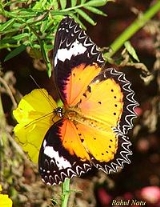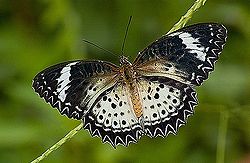
Cethosia cyane
Encyclopedia
The Leopard Lacewing is a species
of heliconiine
butterfly
found from India
to southern China
(southern Yunnan
), and Indochina
. Its range has expanded in the last few decades, and its arrival in the southern part of the Malay Peninsula
, including Singapore
, is relatively recent.

: anterior and apical two-thirds black, the margin of this colour waved and irregular, following a line dividing the cell longitudinally and circling round to near the posterior angle; a short, broad, oblique, white-bar beyond apex of cell, the veins crossing it and a spot in interspaces 3 and 4 black; a transverse indistinct row of small spots and a terminal series of <-shaped lunules white. Hind wing: three or four spots just beyond apex of cell, a subterminal row of spots and the termen broadly black, the last with a series of white lunules as on the fore wing. Underside variegated with red, white, pale blue, ochraceous and black; the terminal margins of both wings broadly black with white lunules as on the upperside; in the middle of each lunule a short white streak from the margin; cilia alternately black and white. Fore wing: the cell with transverse bands of red, blue and black; the base and disc below the cell red spotted with black, followed by pale blue, ochraceous and black; the white oblique band as on upperside, beyond it a transverse incomplete row of lanceolate white marks, with three black spots in each, followed by a subterminal ochraceous band paling inwardly. Hind wing: the base and cell pale blue and red, crossed by several broken incomplete black lines, then alternate bands of white and ochraceous, two of each; the outer white band narrow and marked in each interspace with three black spots arranged as a triangle. Antennae, head and thorax dusky brown; abdomen above tawny, beneath white.

)
Species
In biology, a species is one of the basic units of biological classification and a taxonomic rank. A species is often defined as a group of organisms capable of interbreeding and producing fertile offspring. While in many cases this definition is adequate, more precise or differing measures are...
of heliconiine
Heliconiinae
The Heliconiinae, commonly called heliconians or longwings, are a subfamily of the brush-footed butterflies . They can be divided into 45-50 genera and were sometimes treated as a separate family Heliconiidae within the Papilionoidea...
butterfly
Butterfly
A butterfly is a mainly day-flying insect of the order Lepidoptera, which includes the butterflies and moths. Like other holometabolous insects, the butterfly's life cycle consists of four parts: egg, larva, pupa and adult. Most species are diurnal. Butterflies have large, often brightly coloured...
found from India
India
India , officially the Republic of India , is a country in South Asia. It is the seventh-largest country by geographical area, the second-most populous country with over 1.2 billion people, and the most populous democracy in the world...
to southern China
China
Chinese civilization may refer to:* China for more general discussion of the country.* Chinese culture* Greater China, the transnational community of ethnic Chinese.* History of China* Sinosphere, the area historically affected by Chinese culture...
(southern Yunnan
Yunnan
Yunnan is a province of the People's Republic of China, located in the far southwest of the country spanning approximately and with a population of 45.7 million . The capital of the province is Kunming. The province borders Burma, Laos, and Vietnam.Yunnan is situated in a mountainous area, with...
), and Indochina
Indochina
The Indochinese peninsula, is a region in Southeast Asia. It lies roughly southwest of China, and east of India. The name has its origins in the French, Indochine, as a combination of the names of "China" and "India", and was adopted when French colonizers in Vietnam began expanding their territory...
. Its range has expanded in the last few decades, and its arrival in the southern part of the Malay Peninsula
Malay Peninsula
The Malay Peninsula or Thai-Malay Peninsula is a peninsula in Southeast Asia. The land mass runs approximately north-south and, at its terminus, is the southern-most point of the Asian mainland...
, including Singapore
Singapore
Singapore , officially the Republic of Singapore, is a Southeast Asian city-state off the southern tip of the Malay Peninsula, north of the equator. An island country made up of 63 islands, it is separated from Malaysia by the Straits of Johor to its north and from Indonesia's Riau Islands by the...
, is relatively recent.
Description
- See also Glossary of Lepidopteran termsGlossary of Lepidopteran termsThis glossary describes the terms used in the formal descriptions of insect species, jargon used mostly by professionals or entomologist....

Male
Upperside tawny, in fresh specimens a rich reddish tawny. Fore wingInsect wing
Insects are the only group of invertebrates known to have evolved flight. Insects possess some remarkable flight characteristics and abilities, still far superior to attempts by humans to replicate their capabilities. Even our understanding of the aerodynamics of flexible, flapping wings and how...
: anterior and apical two-thirds black, the margin of this colour waved and irregular, following a line dividing the cell longitudinally and circling round to near the posterior angle; a short, broad, oblique, white-bar beyond apex of cell, the veins crossing it and a spot in interspaces 3 and 4 black; a transverse indistinct row of small spots and a terminal series of <-shaped lunules white. Hind wing: three or four spots just beyond apex of cell, a subterminal row of spots and the termen broadly black, the last with a series of white lunules as on the fore wing. Underside variegated with red, white, pale blue, ochraceous and black; the terminal margins of both wings broadly black with white lunules as on the upperside; in the middle of each lunule a short white streak from the margin; cilia alternately black and white. Fore wing: the cell with transverse bands of red, blue and black; the base and disc below the cell red spotted with black, followed by pale blue, ochraceous and black; the white oblique band as on upperside, beyond it a transverse incomplete row of lanceolate white marks, with three black spots in each, followed by a subterminal ochraceous band paling inwardly. Hind wing: the base and cell pale blue and red, crossed by several broken incomplete black lines, then alternate bands of white and ochraceous, two of each; the outer white band narrow and marked in each interspace with three black spots arranged as a triangle. Antennae, head and thorax dusky brown; abdomen above tawny, beneath white.

Female
Similar to the male in markings, but the tawny groundcolour replaced by pale greenish white, somewhat brownish on the upperside of fore wing, the extent of black on this wing larger. Underside with all the markings paler than in the male the red at the base of the wings replaced by brownish yellow on the fore, white on the hind wing. Antennae, head and thorax dusky brown; abdomen dusky above, white beneath.Larva
"Cylindrical, purplish-black segments with alternate yellow and crimson bands. Head armed with two long spines, segments with dorsal and lateral rows of fine spines. Feeds on Passiflora, July. (Described from drawing by Major C. H. E. Adamson.)." (Frederic MooreFrederic Moore
Frederic Moore FZS was a British entomologist. It has been said that Moore was born at 33 Bruton Street but may be incorrect given that this was the address of the menagerie and office of the Zoological Society of London from 1826 to 1836.Moore was appointed an assistant in the East India Company...
)

